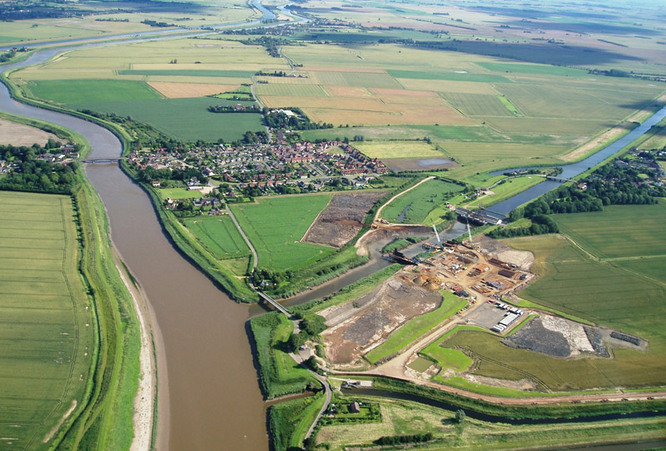Trustees: Scilla Ash, Margaret Bunkall, Robert Rawlings, Tony Burt, Jaqueline Wardale.
What is the ‘Bridge Charity’ and what does it do?
The St Germans bridge dates back to Saxon times, it is believed it to have been a toll bridge in the early 1600’s and that in 1691 Thomas Fenn bequeathed £25 for the poor. That capital investment brought in 25 shillings a year in interest, which along with an endowment of six shillings and eight pence, left by an unknown donor; the charity became known as the Fenns and Bridge Charity. In 1928 records show that the bridge reeves[1] owned the bridge along with 4 cottages, known as the Bridge Cottages, and a 90 square yards plot at Mill Road with a building on it, known as the Reading Room. The Bridge Cottages were let to the poor widows of the parish rent free and maintained by the bridge reeves. The bridge was latter let out on a monthly basis with a rent of eight pounds and five shillings per month to a Mr H Bridges, who then collected the tolls for himself.
On Thursday, January 28th 1928, the bridge reeves, Mr R Alan and Mr W Easter convened a public meeting of the inhabitants of St Germans in the Reading Room to formulate a basis of negotiation in view of the possibility of the County Council’s exceptions of the responsibility of the care and upkeep of the bridge. The room was crowded with parishioners practically unanimous for the principle of a free bridge. The bridge reeves declared the bridge funds to be around £2000. It was finally decided to offer the bridge to the County Council, it was eventually handed over and a new bridge was built and opened in 1938.
In July 1971 the clerk informed the trustees that net income from the sale of the almshouses (Bridge Cottages) and the Reading Room, came to £252 and 22 and half pence, the clerk was instructed to invest £250 of this in three 0.5% war stocks. In the original Scheme of 8th April 1928 registered with the Charities Commission, the application of income was directed toward the maintenance of the cottages and reading room, coal for widows of the parish and general benefit of the poor in the form of donations to the local infirmary, hospital, dispensary and convalescent homes as well as the supply of clothes, boots, bedding, linen, fuel, tools and medical or other aid to sickness.
The Scheme was updated in 1986 and forms the constitution and guides how the charity operates to today; with sound investments through a Charity Investments company, the dividends amount to an average income of around £1200 p.a. with the Bridge Charity now void of property it relies on the return from those investments. The application of income is limited to the clear income each year and can be granted generally or individually to residents of the Parish of Wiggenhall St Germans, who are in a condition of hardship or distress; with the NHS and Social Benefits systems catering for most needs in modern times there are few in the Parish who would qualify in the same way as the charity was originally set up to provide for, so the Trustees take a wider view and interpretation of the Schedule to benefit the community as a whole.
The Charities main application of the income currently is to provide a school uniform grant to the parents and guardians of children of the parish that are transitioning to High School, this is to help with the uniform costs that can be significant and it removes some of the stress and inequalities that can make those important early days in secondary education difficult for children and parents.
The charity has also considered grants to community organisations over the last 20 years such as a start-up grant for the Parent and Toddler Group, Community Post Office and Parochial Church Council projects. The Trustees often find it difficult to ensure that the applications meet the intent of the criteria in the schedule for the application of income and the spirit of the grants made needs careful consideration. The Church was granted a donation of £586 in 2006 for a hearing induction loop, the church having raised £2000, this donation ensured the target was met and benefitted the hard of hearing in the parish.
The Charity accepts applications for grants or donations in accordance with this policy.
The Trust has maintained close relations with the Parish Council and the Council is responsible for appointing 3 Trustees every 4 years with a further 2 co-opted to serve for 5 years; currently 3 parish councillors are double-hatted as Trustees and the clerk of the council also voluntarily carries out the role of clerk/correspondent for the charity. Like the Parish Council, the St Germans Bridge Trust is always looking for ways to help the community and other ideas such as supporting those starting apprenticeships or University with specific needs was under consideration. However, the Trustees are not the sole arbiters of good ideas and are aware that just as the world changes (never more so than during the current pandemic), so the need to be pragmatic, imaginative, responsive and contemporary with application of the fund to be effective; so if you have ideas of how the charity might meet the needs of the community that might otherwise be overlooked or disadvantaged, then please contact the Bridge Charity via the clerk using the Parish Council email [email protected] or by post to M Inder (Bridge Charity Clerk), 4 Lime Close, Marham, PE33 9HN.
[1] Originally in Anglo-Saxon England the reeve was a senior official with local responsibilities under the Crown
